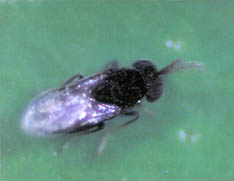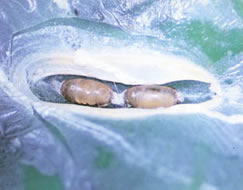Classical Biological Control of the Citrus Leaf Miner (CLM) in Florida: a Progress Report
By: M. A. Hoy and R. Nguyen, University of Florida, IFAS, Entomology and Nematology Department, Gainesville, and Division of Plant Industry, Gainesville
Classical biological control involves the importation, rearing, release, and establishment of host- specific natural enemies of foreign pests. Such host-specific natural enemies, which may be either parasites, predators or pathogens, could provide substantial biological control of the CLM in Florida. This report provides an update on progress toward that goal.
Classical biological control is often a cooperative endeavor, with scientists from other countries providing information and assistance to colleagues attempting to collect effective natural enemies of pests that are widespread in their distribution. Our classical biological control project is no exception, and we owe a particular debt of gratitude to two Australian scientists. Dan Smith, Principal Entomologist at the Maroochy Horticultural Research Station in Nambour organized an unusually successful collecting expedition in Queensland Australia (photo), as well as providing expert assistance in processing thousands of citrus leaves infested with the parasitized CLM. Up to 90% of the CLM was parasitized by three species of parasites in these samples. Only three years ago, Dan Smith and Dan Papacek had released two parasite species from Thailand in Queensland citrus groves. Although these parasites have only recently established there, the parasites killed up to 80-90% of the CLM in the Queensland citrus groves sampled during April 1994.
One parasite, Ageniaspis citricola Logvinovskaya, dominated in all the citrus groves visited in April. Because A. citricola was so abundant, about three thousand pupae were hand carried from Australia directly into the Division of Plant Industry's Quarantine facility on April 25. We immediately began to identify, sort, and rear the parasites. Specimens also were shipped on April 25 to the British National Museum in London for identification by taxonomic experts John LaSalle and John Noyes. They confirmed, within twenty-four hours by the internet and fax, that we had imported the correct species. However, we recognized that most of the A. citricola pupae carried back from Australia would be lost because we had limited space and host material in the quarantine facilities. We therefore decided to request permission to release the adults that emerged from these pupae into Florida citrus groves. However, permission to take A. citricola adults out of quarantine would have to be granted rapidly or they would die within a few days. The race was on to determine if state and federal regulatory agencies would approve the release of the adults!
 Division of Plant Industry officials Richard Gaskalla and Connie
Riherd provided able support in winning that race. Meetings were
called and a package of information on the biology and host specificity
of A. citricola was presented and discussed. The confirmation of
the identity of the specimens by independent taxonomic experts John
LaSalle and John Noyes in England was a key element in the decision
by Florida regulatory officials to approve on April 27 the releases
of A. citricola adults, as was the information about its biology
and host specificity. Scientists at the United States Department
of Agriculture Animal and Plant Health Inspection Service, Plant
Protection and Quarantine in Hyattsville, Maryland evaluated the
application and promptly prepared their evaluation and reports. On
late Friday afternoon on April 29, we received permission to release
adults of A. citricola from quarantine if we inspected each individual
under a microscope to confirm that only A. citricola adults were
released.
Division of Plant Industry officials Richard Gaskalla and Connie
Riherd provided able support in winning that race. Meetings were
called and a package of information on the biology and host specificity
of A. citricola was presented and discussed. The confirmation of
the identity of the specimens by independent taxonomic experts John
LaSalle and John Noyes in England was a key element in the decision
by Florida regulatory officials to approve on April 27 the releases
of A. citricola adults, as was the information about its biology
and host specificity. Scientists at the United States Department
of Agriculture Animal and Plant Health Inspection Service, Plant
Protection and Quarantine in Hyattsville, Maryland evaluated the
application and promptly prepared their evaluation and reports. On
late Friday afternoon on April 29, we received permission to release
adults of A. citricola from quarantine if we inspected each individual
under a microscope to confirm that only A. citricola adults were
released.
The first A. citricola were released on Saturday, April 30, at two sites. Harold Browning at the Citrus Research and Extension Center and David Hall, U. S. Sugar Corporation, each released 200 adults of A. citricola into plots at the CREC in Lake Alfred and near Clewiston, respectively. Additional releases were made on May 2 at two commercial groves by Harold Browning near Lake Placid and by Phil Stansly of IFAS near Immokelee. Additional parasites were provided to Philip Rucks of Berry Farms, and Robert Bullock and Jorge Pena of IFAS, for releases May 4-6 in Fort Pierce, Winter Haven, and Homestead, respectively. We released a few parasites into a citrus grove on the campus of the University of Florida in Gainesville on May 5 and also initiated laboratory colonies in Gainesville. A total of approximately 1600 adult A. citricola were released in Florida citrus groves between April 30 and May 6.
Only time will tell if A. citricola will establish. We expect it to establish in Florida because both the Asian collection sites and the Australian establishment sites have a climate that is similar to that of Florida. However, release conditions are critical. Parasite releases should be made in sites where abundant CLM are present. The orchard should not have been treated with pesticides (including oil) prior to the releases and should remain free of all pesticides (insecticides, acaricides, fungicides) during the next year so that both CLM and A. citricola can multiply. Without CLM available as a host throughout the year, A. citricola cannot persist. We hope that the parasites just released will establish, multiply, and disperse from the release sites into other citrus groves nearby.
Additional releases of A. citricola also will be made using parasites reared in cages in Gainesville. However, it is difficult to rear large numbers of both the CLM and its parasites in the laboratory, so additional releases of A. citricola will consist of small numbers.
Biology and Efficacy of Ageniaspis citricola (Hymenoptera: Encyrtidae)
A. citricola is a host-specific internal parasite of the CLM, which means that it must have CLM as a host or it will disperse or die. It appears to be able to disperse rapidly, because it has spread throughout Queensland within three years and has been reported to disperse as far as 300 km within a year.
A. citricola appears to be an effective and dominant parasite of CLM in Queensland. Of the three parasite species collected in Queensland citrus groves, A. citricola was the most abundant parasite. About 80-90% of the CLM were parasitized and at least 80% of the parasitism was due to A. citricola. In two humid coastal orchards, flush in the orchards was 6-8 inches long but few leaf miners could be found. Likewise, A. citricola is the most common parasite collected from CLM in Thailand, parasitizing up to 80% of the pest there.
Females of A. citricola are reported to attack both eggs and small larvae of the CLM. After being parasitized, the CLM larvae continue to feed and develop in the leaf mines. A. citricola kills its host after the CLM forms its pupal chamber on the leaf margin. A. citricola then pupates within the apparently-normal CLM pupal chamber and the adult females emerge to begin the cycle over again. The pupal chamber has to be opened to see that parasite pupae are present instead of a CLM pupa (photo).
A. citricola is a small black uniparental parasite (females only) and no males are known. It is polyembryonic, producing from one to eight tan or brown pupae per citrus leaf miner pupal chamber. Originally, the pupae are light tan, but become darker brown, and eventually the black adults can be seen within the pupal chamber just before they emerge. Even under ideal conditions, adults of A. citricola are relatively short lived (4-15 days). They appear to be well adapted to hot, humid climates; dry environments are reported to kill them.
 The Queensland citrus growers interviewed indicated that they do
not consider the CLM to be a serious pest in mature groves because
their first spring flush is not attacked and parasites suppress later
populations of CLM. While the parasites do not eliminate the CLM,
the growers appeared willing to tolerate CLM infestations in mature
groves.
The Queensland citrus growers interviewed indicated that they do
not consider the CLM to be a serious pest in mature groves because
their first spring flush is not attacked and parasites suppress later
populations of CLM. While the parasites do not eliminate the CLM,
the growers appeared willing to tolerate CLM infestations in mature
groves.
Additional Parasites Collected
Two additional host-specific parasite species were collected from the CLM in Queensland and imported into the quarantine facility in Gainesville. Small colonies of these parasites were initiated, and we hope to receive permission to release them from quarantine soon. Because only a few specimens were imported, it will take several months for us to rear adequate numbers for releases into Florida citrus groves.
Benefits to Florida Citrus Growers
Classical biological control of the CLM offers the promise of providing long term and relatively inexpensive control. Biological control can reduce production costs in mature groves by reducing pesticide applications, and is an essential component in a pesticide-resistance management program for CLM.
The results of the releases will be monitored to determine if A. citricola establishes. If A. citricola establishes and persists throughout the summer, the next question to be answered is whether it can survive the winter. The prospects are good. Historically, host specific-natural enemies from climatically-similar regions have had a high rate of establishment in the new environment. Once established, they could have a substantial impact on the pest within two to three years.
Many people and agencies cooperated to get A. citricola into Florida citrus groves. We thank everyone for their enthusiastic assistance and support.
Originally published in The Citrus Industry in 1994.


